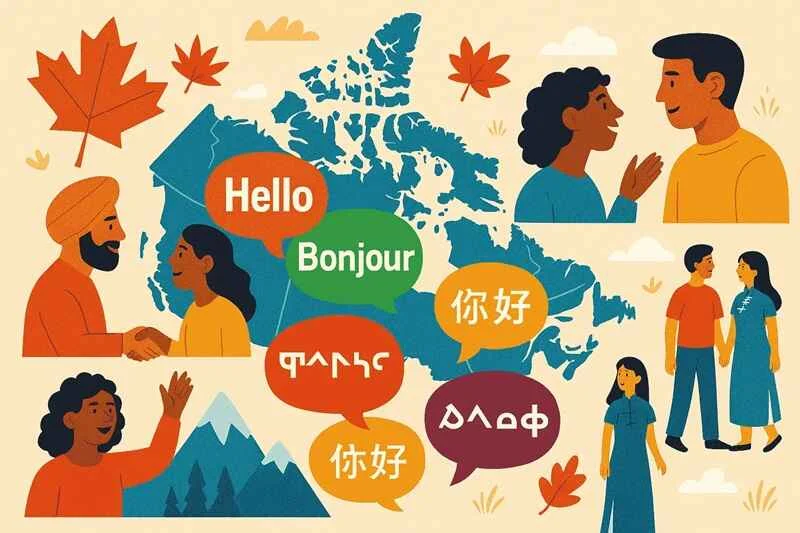When we think of Canada, we envision beautiful landscapes, friendly communities, and a multicultural society. But beyond the maple syrup and mountains lies something just as fascinating: the Languages of Canada. From official bilingualism to resilient Indigenous tongues and vibrant immigrant dialects, these Languages of Canada don’t just communicate—they tell the story of the people themselves.
What Languages Are Spoken in Canada?
Canada officially recognizes English and French, but is home to over 200 languages thanks to generations of immigration and its Indigenous roots. Here’s a quick look at the top three:
- English: Spoken by most Canadians, English is used in daily life, education, business, and media.
- French: Canada’s second official language, French is part of Quebec culture and is heard in several provinces, especially in the east.
- Mandarin: The most spoken immigrant language, Mandarin has a strong presence in major cities like Toronto and Vancouver.
These languages are the foundation of communication in Canada — but they’re just the beginning of a much bigger story.
English and French: Canada’s Official Languages
-
English: Spoken from Coast to Coast
With around 75% of Canadians speaking English, it’s the most common language in Canada. Whether you’re watching the news, applying for a job, or ordering coffee, English is what you’ll use.
-
French: Deep Roots in Canadian Culture
French is more than just a second language; it’s part of Canada’s heritage. It’s strong in Quebec, where it’s the official provincial language and also heard in parts of Ontario and New Brunswick. The federal government supports bilingualism by offering services and education in both languages.
Are you looking for professional French language support? Whether it’s translation, interpretation, or bilingual communication, TransLinguist’s French services can help you connect across languages with confidence.
Indigenous Languages: The Voices of the Land
Before English and French arrived, Indigenous peoples across Canada were speaking their languages — some of which are still alive today. There are over 70 Indigenous languages spoken in Canada, many of which are at risk of disappearing. Cree, Ojibwe, Inuktitut.
Cree and Ojibwe are spoken in central and northern Canada.
Inuktitut is spoken in Nunavut and other Arctic regions by Inuit communities.
These languages hold the cultural knowledge, stories, and traditions of the First Peoples and are part of Canada’s fabric. Efforts are being made to revitalize them through education, media, and community programs.
Supporting Indigenous and endangered languages is key to preserving cultural identity. At TransLinguist, we’re bridging language gaps across cultures. Check out our language services and see how we can help you communicate across languages.
Immigrant Languages: Canada’s Fabric
Thanks to its open immigration policies, Canada is one of the most multicultural countries in the world. That diversity is reflected in the languages spoken at home, in neighborhoods, and at cultural festivals.
Some of the most common immigrant languages are:
- Mandarin and Cantonese: Common in Chinese communities, especially in BC and Ontario.
- Punjabi: Widely spoken in South Asian communities in Vancouver and Toronto.
- Tagalog (Filipino): A growing language due to strong Filipino immigration.
- Arabic, Spanish, and Urdu: Also spoken in many cities across Canada.
In cities like Toronto, over 50% of residents speak a first language other than English or French.
Language Policy and Bilingualism in Canada
In Canada, both English and French are used in everyday life. The government makes sure people can get services in either language, thanks to the Official Languages Act. You can see both languages in schools, on packaging, and even during airplane announcements.
Many kids who speak English at home go to French immersion schools. This helps them learn another language and can give them more job options in the future.
Why Language Matters in Canada
Language in Canada does more than help people talk—it brings people together. Having many languages makes the country more welcoming and connected. You might hear French in a café in Montreal or Punjabi at a community center in Vancouver—every language adds something special to Canada’s culture.
Conclusion:
Canada is known for having many languages. English and French are the official languages, but Indigenous and immigrant languages are also a big part of the culture. In today’s connected world, speaking many languages is a big advantage.
At TransLinguist, we offer translation and interpretation services for business, travel, school, or community needs. Contact us to see how we can help you speak clearly across languages and cultures.
FAQs
What are the top 3 languages in Canada?
The top 3 languages in Canada are English, French, and Punjabi. English and French are official languages, while Punjabi is the most spoken immigrant language.
What are the cultural languages in Canada?
Cultural languages in Canada include Indigenous languages like Inuktitut, Cree, and Ojibwe, as well as heritage languages such as Punjabi, Mandarin, Arabic, and Italian—reflecting the country’s diverse roots.
What languages were declared the official languages of Canada in 1969?
English and French were declared the official languages of Canada in 1969 under the Official Languages Act.
Which language is important in Canada?
English and French are the most important languages in Canada, as they’re both official and used in government, education, and public services.
What is Canada's first language?
Canada doesn’t have a single “first language,” but English is the most commonly spoken, while French is the first language for many, especially in Quebec. Both are official languages.



